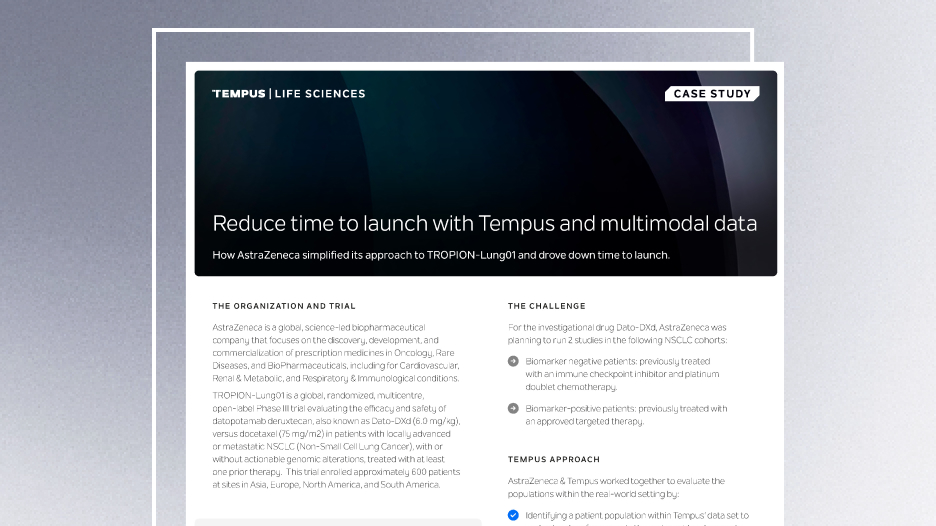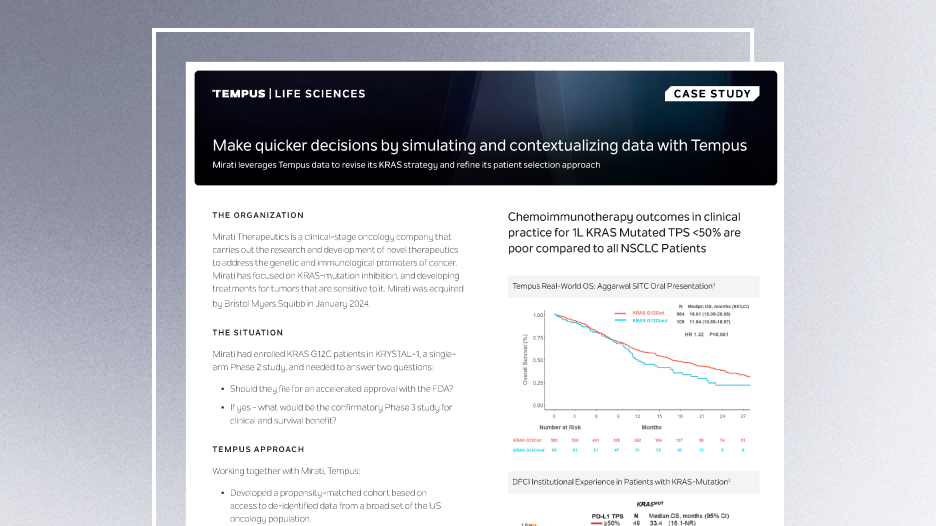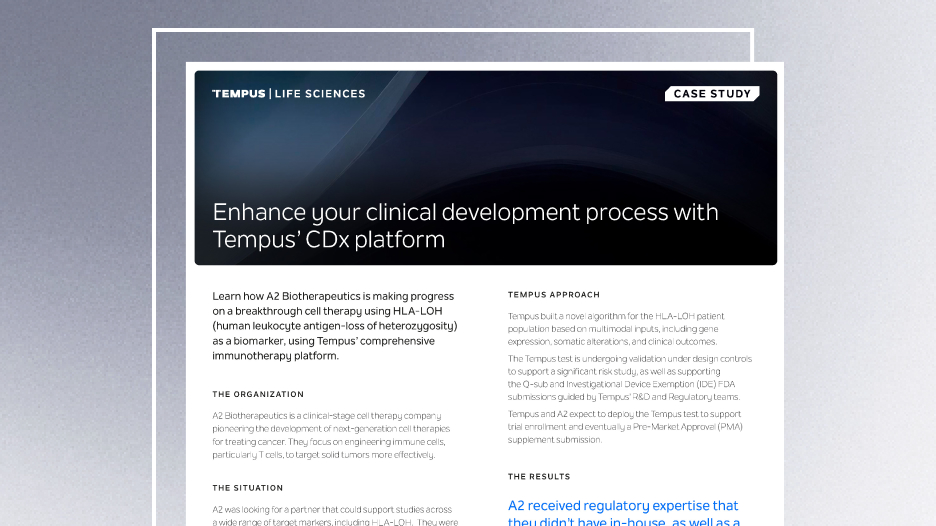-
PROVIDERS
Read more
Browse our latest selection of abstracts, manuscripts, and presentations.
-
LIFE SCIENCES
LIVE WEBINAR
Optimizing research with RWD: How Lens accelerates time to insights in drug discovery.
Register now. -
PATIENTS
It's About Time
View the Tempus vision.
- RESOURCES
-
ABOUT US
View Job Postings
We’re looking for people who can change the world.
02/01/2023
Precision medicine made real: enhancing genetic testing with AI algorithms
Authors
Martin Stumpe, Chief of AI
Speakers
Martin Stumpe, Chief of AI
Genetic testing has been a breakthrough in clinical research and patient profiling, allowing providers to pinpoint the precise factors in a person’s genome that may affect their health or response to treatments. Today, researchers have the potential to learn more from each genetic test without collecting additional samples or adding more work for an ordering physician. By leveraging artificial intelligence (AI) on top of existing data at scale, we can build algorithmic diagnostics that generate new insights to personalize care for patients.
AI algorithms can analyze information across multimodal datasets – including pathology and radiology images, genomics, and clinical data – to connect the dots of a patient’s health and unlock new information that may inform their diagnosis, treatment options, or their eligibility to participate in a clinical trial.
We’ve built a variety of these AI-driven algorithms at Tempus. Our Tempus|TO (or tumor origin) test uses RNA expression results from tumor metastases to predict the patient’s most likely cancer type from 68 possible diagnoses. In a retrospective study presented at ESMO 2022, Tempus|TO was shown to provide meaningful data that would have affected physicians’ treatment decision-making for patients with cancer of unknown primary (CUP). In a study of 289 patients, 81% of patients with CUP would have their treatment informed by TO tumor classification, ultimately expanding the treatment options for CUP patients and demonstrating how combining machine learning (ML)-generated insights with providers’ expertise can power a more precise treatment than either entity could do alone.
How Tempus develops novel digital diagnostics
Tempus is deploying AI algorithms to strengthen diagnostic testing with our provider and life sciences partners. With Tempus’ capabilities, over 60 petabytes of data in our multimodal database can be harnessed alongside our analytic capabilities. Tempus’ database has grown to be approximately 20 times the size of the Cancer Genome Atlas, the largest public genomic database, based on petabytes of data, making us uniquely positioned to build and validate models that providers and researchers can use to advance precision medicine.
We’ve seen a great deal of adoption of these algorithms with our physician partners. Today, 25 percent of orders for Tempus’s genomic tests include at least one of our four existing algorithmic diagnostics, which provide additional insights into a patient’s disease and ultimately help personalize their care more deeply. To continue to build on this momentum, we consider a few key elements when determining what additional algorithms have the potential to improve patient care, including:
-
- Would this information help doctors optimize clinical decision making?
- Is it scientifically feasible to gather this information? Does the data exist to answer the clinical questions of interest?
- Are we logistically able to address research questions using this algorithm? Do we have access to the right data and analytic resources to answer it?
For providers: Adding new insights without increasing workloads
Historically, the notion of AI in clinical practice seems like a big black box that is out of reach. So, we intentionally make algorithms easy for doctors to use in the clinic. Because providers are inundated with data and have limited time to spend with patients, we try to avoid asking them to create new processes or to gather new or additional samples from patients. Instead, we can layer algorithms onto the existing diagnostics and technology they already use and order every day, removing a significant adoption barrier while enhancing the results physicians expect from genetic testing.
Physicians receive the ML-generated information in a clinical report delivered alongside the test results they ordered for their patients. When a physician orders a Tempus test with an algorithm, they’ll receive additional insights and information that may, for instance, indicate where a patient’s cancer originated if it wasn’t able to be determined prior to the test.
Tempus is also introducing algorithms earlier in the patient journey that can identify potential actionable biomarkers for patients who are in the pathology and radiology stage of their journey and haven’t been sequenced yet. Our digital pathology platform allows pathologists to access investigational algorithms designed to surface patients that are more likely to have targetable biomarkers, which can be confirmed with additional testing, such as next-generation sequencing. With Tempus’ recent acquisition of Arterys, we can also deploy its dedicated medical imaging platform with a comprehensive set of clinical AI workflow solutions for radiologists to enhance patient care.
For life sciences: Improving clinical research with more precise patient selection
Biopharma can also benefit from this technology, through the process of identifying patients for clinical trials or targeted therapies. Conversely, these algorithms can help predict which patients may be unlikely to respond to specific drugs and, therefore, should not be included in a certain study. AI-enabled diagnostics can also inform early drug development, including pinpointing patient populations that may not have been treated effectively before and predicting adverse events.
Overcoming adoption barriers to advance precision medicine
In the last few years, FDA has begun classifying many AI/ML-enabled tools as medical devices to improve patient care, but many questions remain that may hinder adoption by clinical practitioners. How should regulators assess the validity of algorithms? How do AI algorithmic tests compare with traditional medical devices, and what does that mean for their regulation? And how can we ensure that these AI-enabled tools are without bias and address the needs of entire patient populations?
Others in the industry – healthcare providers and life sciences companies included – may wonder how they can add algorithmic testing to clinical or R&D workflows, or how they can demonstrate their value to reimbursement bodies. Collaboration across the industry, including through cross-functional working groups and pilot projects, will be key to answering these questions and advancing adoption.
Building a future for digital diagnostics
At Tempus, we believe that ML algorithms can augment our clinical understanding of patients and provide unique insights that can better inform patient care. Tempus has made strides to improve traditional diagnostics with AI methodology. We’ve begun to layer ML models onto common cardiology tests to make them smarter. By adding models to clinically acquired electrocardiograms (ECGs), we can gain new insights that may enhance the ECG test’s functionality.
In the future, Tempus will continue building a larger menu of algorithmic diagnostics to layer onto existing diagnostic tests, such as xT, Tempus’ broad-panel sequencing test, which providers can then select depending on their patient’s profile and individual needs. Recognizing that others share our vision for a data and AI-enabled future of medicine, we aim to empower our collaborators to build algorithms and validate them using our data and our platform. Through our Tempus AI Advisors Program (TAAP), we’ve opened access to our database so researchers can develop and validate novel clinical, molecular, and/or imaging-based algorithms to improve patient care – and potentially incorporate them into our Tempus offerings.
There are many open questions and healthcare challenges to explore: How do we reduce the number of undiagnosed and misdiagnosed diseases? How can we make meaningful steps toward health equity by identifying patients with unmet medical needs and learning how to address them? With ML-powered diagnostics, we can go further than ever before to answer these questions and make precision medicine a reality for patients.
-
04/16/2024
Reduce time to launch with Tempus and multimodal data
How AstraZeneca simplified its approach to TROPION-Lung01 and drove down time to launch.
Read more -
04/16/2024
Make quicker decisions by simulating and contextualizing data with Tempus
Mirati leverages Tempus data to revise its KRAS strategy and refine its patient selection approach
Read more -
04/16/2024
Enhance your clinical development process with Tempus’ CDx platform
Learn how A2 Biotherapeutics is making progress on a breakthrough cell therapy using HLA-LOH (human leukocyte antigen-loss of heterozygosity) as a biomarker, using Tempus’ comprehensive immunotherapy platform.
Read more


